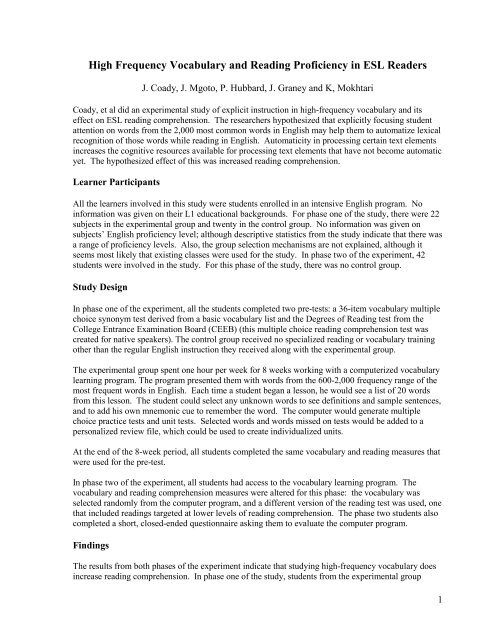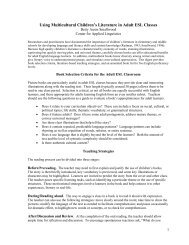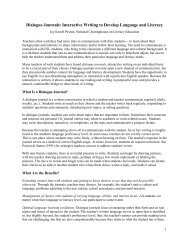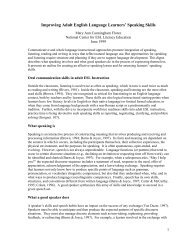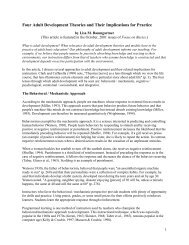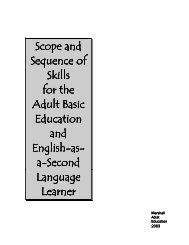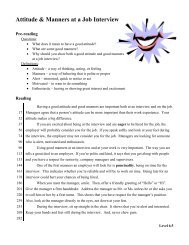High Frequency Vocabulary and Reading Proficiency in ESL Readers
High Frequency Vocabulary and Reading Proficiency in ESL Readers
High Frequency Vocabulary and Reading Proficiency in ESL Readers
You also want an ePaper? Increase the reach of your titles
YUMPU automatically turns print PDFs into web optimized ePapers that Google loves.
<strong>High</strong> <strong>Frequency</strong> <strong>Vocabulary</strong> <strong>and</strong> <strong>Read<strong>in</strong>g</strong> <strong>Proficiency</strong> <strong>in</strong> <strong>ESL</strong> <strong>Readers</strong>J. Coady, J. Mgoto, P. Hubbard, J. Graney <strong>and</strong> K, MokhtariCoady, et al did an experimental study of explicit <strong>in</strong>struction <strong>in</strong> high-frequency vocabulary <strong>and</strong> itseffect on <strong>ESL</strong> read<strong>in</strong>g comprehension. The researchers hypothesized that explicitly focus<strong>in</strong>g studentattention on words from the 2,000 most common words <strong>in</strong> English may help them to automatize lexicalrecognition of those words while read<strong>in</strong>g <strong>in</strong> English. Automaticity <strong>in</strong> process<strong>in</strong>g certa<strong>in</strong> text elements<strong>in</strong>creases the cognitive resources available for process<strong>in</strong>g text elements that have not become automaticyet. The hypothesized effect of this was <strong>in</strong>creased read<strong>in</strong>g comprehension.Learner ParticipantsAll the learners <strong>in</strong>volved <strong>in</strong> this study were students enrolled <strong>in</strong> an <strong>in</strong>tensive English program. No<strong>in</strong>formation was given on their L1 educational backgrounds. For phase one of the study, there were 22subjects <strong>in</strong> the experimental group <strong>and</strong> twenty <strong>in</strong> the control group. No <strong>in</strong>formation was given onsubjects’ English proficiency level; although descriptive statistics from the study <strong>in</strong>dicate that there wasa range of proficiency levels. Also, the group selection mechanisms are not expla<strong>in</strong>ed, although itseems most likely that exist<strong>in</strong>g classes were used for the study. In phase two of the experiment, 42students were <strong>in</strong>volved <strong>in</strong> the study. For this phase of the study, there was no control group.Study DesignIn phase one of the experiment, all the students completed two pre-tests: a 36-item vocabulary multiplechoice synonym test derived from a basic vocabulary list <strong>and</strong> the Degrees of <strong>Read<strong>in</strong>g</strong> test from theCollege Entrance Exam<strong>in</strong>ation Board (CEEB) (this multiple choice read<strong>in</strong>g comprehension test wascreated for native speakers). The control group received no specialized read<strong>in</strong>g or vocabulary tra<strong>in</strong><strong>in</strong>gother than the regular English <strong>in</strong>struction they received along with the experimental group.The experimental group spent one hour per week for 8 weeks work<strong>in</strong>g with a computerized vocabularylearn<strong>in</strong>g program. The program presented them with words from the 600-2,000 frequency range of themost frequent words <strong>in</strong> English. Each time a student began a lesson, he would see a list of 20 wordsfrom this lesson. The student could select any unknown words to see def<strong>in</strong>itions <strong>and</strong> sample sentences,<strong>and</strong> to add his own mnemonic cue to remember the word. The computer would generate multiplechoice practice tests <strong>and</strong> unit tests. Selected words <strong>and</strong> words missed on tests would be added to apersonalized review file, which could be used to create <strong>in</strong>dividualized units.At the end of the 8-week period, all students completed the same vocabulary <strong>and</strong> read<strong>in</strong>g measures thatwere used for the pre-test.In phase two of the experiment, all students had access to the vocabulary learn<strong>in</strong>g program. Thevocabulary <strong>and</strong> read<strong>in</strong>g comprehension measures were altered for this phase: the vocabulary wasselected r<strong>and</strong>omly from the computer program, <strong>and</strong> a different version of the read<strong>in</strong>g test was used, onethat <strong>in</strong>cluded read<strong>in</strong>gs targeted at lower levels of read<strong>in</strong>g comprehension. The phase two students alsocompleted a short, closed-ended questionnaire ask<strong>in</strong>g them to evaluate the computer program.F<strong>in</strong>d<strong>in</strong>gsThe results from both phases of the experiment <strong>in</strong>dicate that study<strong>in</strong>g high-frequency vocabulary does<strong>in</strong>crease read<strong>in</strong>g comprehension. In phase one of the study, students from the experimental group1
experienced significantly greater ga<strong>in</strong>s <strong>in</strong> both read<strong>in</strong>g comprehension <strong>and</strong> vocabulary knowledge thanthe control group (F(41,1)=9.55,p
Questions for <strong>in</strong>dividual consideration or group discussion:1) What is bottom-up text process<strong>in</strong>g? What is top-down text process<strong>in</strong>g? What are some examples ofteach<strong>in</strong>g/learn<strong>in</strong>g activities for each type of process<strong>in</strong>g? Which type do you teach <strong>and</strong> why?2) Have you explicitly taught words from the 2000 most common words <strong>in</strong> English list before? If so,what outcomes have you noted? Did you teach these words embedded <strong>in</strong> a relevant context, or <strong>in</strong> adecontextualized way? Which way do you prefer <strong>and</strong> why?3) It appears from the study design that the experimental group received 8 additional hours of direct<strong>in</strong>struction compared to the experimental group. Could these hours have led to their additional ga<strong>in</strong>s?Why or why not?4) Do you th<strong>in</strong>k that study<strong>in</strong>g the list of high-frequency vocabulary <strong>in</strong>creases read<strong>in</strong>g comprehension<strong>in</strong> general, or comprehension of read<strong>in</strong>gs <strong>in</strong>clud<strong>in</strong>g those vocabulary words? Is it clear from thisstudy? What has been your experience?5) How might the results of this study affect your teach<strong>in</strong>g? Why?3


